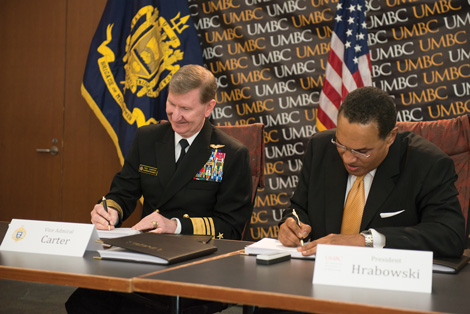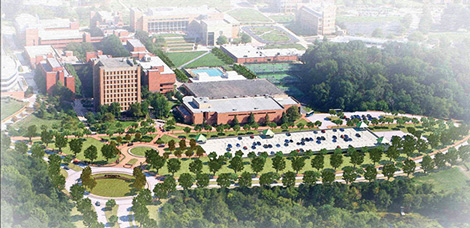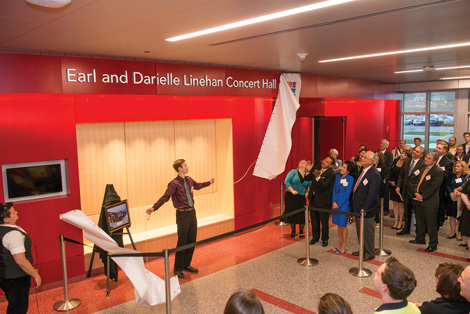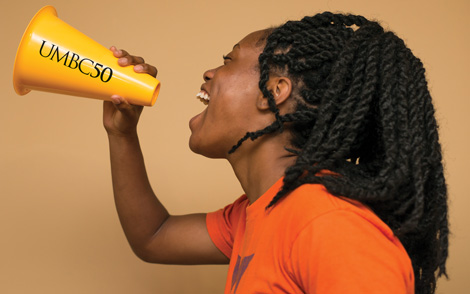Anchors Aweigh
The U.S. Navy has a proud history in Maryland. And with two new agreements concluded in April, UMBC deepened its educational and research ties with the Navy in significant ways.
UMBC students are now eligible to steer a course to become commissioned officers in the Navy and Marine Corps with the establishment of a Naval ROTC (NROTC) program at the university.
The agreement with the Naval Service Training Command (NSTC) makes UMBC the first higher education institution in Maryland to be selected as an NROTC host. A professor of naval science, appointed by the NSTC in collaboration with UMBC, will lead the new program and coordinate instruction on campus.
“We are delighted to have been selected for this honor,” says UMBC President Freeman A. Hrabowski, III. “Many of our students are from military families, and many want to serve their country through the Navy. Already, hundreds of our graduates are working for the Navy. We envision many more doing so through this program.”
UMBC will join an exclusive club of 75 colleges and universities in the nation who host a NROTC program. The agreement is part of the new Maryland NROTC consortium that includes the University of Maryland, College Park. UMBC students can also participate in the Army University ROTC program through Johns Hopkins University, and also the Air Force ROTC program through the University of Maryland, College Park.
“By partnering with UMBC, we are continuing to work with elite colleges and universities committed to producing graduates with exemplary education, character, and leadership for service to our nation,” says Rear Adm. Richard A. Brown, who serves as commander of the NSTC.
“I am so pleased that the U.S. Navy is establishing an ROTC program at UMBC,” says U.S. Senator Barbara Mikulski (D-Maryland). “With the Naval Academy already in Annapolis, Maryland has a proud history of supporting those who sacrifice so much to keep us safe. Now, UMBC, a longtime leader in math and science education, will grow that historic relationship.”
UMBC also deepened its research relationship with the Navy when Hrabowski signed a Collaborative Research and Development Agreement (CRADA) with U.S. Naval Academy (USNA) Superintendent Vice Admiral Ted Carter on April 21, 2015. The CRADA formalizes opportunities for collaboration between faculty from UMBC and the Naval Academy, and five projects have already been awarded funding from the Office of Naval Research.
One team is working to create quantum computers that could be exponentially faster than traditional computing technologies. Physics researchers are taking advantage of nanoscale defects in the structure of diamonds, and an atomic property called “spin.”
Other projects already in the pipeline focus largely on security issues. One team hopes to generate self-aware computer systems that can detect when they’re being hacked. Another group is developing computer programs to detect cyberattacks via social media posts. Projects to make cloud computing and mobile devices more secure also obtained funding.
“People have been asking us for a long time to get more connected to the Navy,” says Hrabowski. These new agreements put UMBC and the Navy on the high seas of collaboration.
— Max Cole and Sarah Hansen
Safe on Arrival
After more than a year of construction, UMBC’s campus entrance project is finally open to welcome the campus community and the many visitors to the university.
The $13.5 million renewal and renovation of the main gateway to campus – which connects UMBC to the Baltimore-Washington technology corridor via major regional highways – boasts two roundabouts, a new traffic pattern, an entrance plaza that embraces the latest concepts in shared space for vehicles and pedestrians, and much-enhanced landscaping.
Those who enter campus via UMBC Boulevard will discover that it now features two travel lanes, with a new roundabout at the entrance to the bwtech@UMBC research park. The route has been landscaped to eventually provide a canopy of towering trees and flowering understory trees.
Other improvements accompany the project as it winds into the university’s main campus. A modern sign with champagne and charcoal stone and bronze lettering graces the entrance. UMBC Boulevard now flows into a large traffic rotary at Hilltop Circle that directs motorists as they enter campus. The rotary also connects to a new and more-pedestrian friendly entrance to the main campus itself.
The new entrance was designed both to heighten safety and boost UMBC’s aesthetic beauty, says Joe Rexing, UMBC’s campus architect and director of capital planning and construction. He says that the project reflects the energy of a young and forward-looking university.
“The impetus of the project was safety,” says Rexing. Yet the chance to remedy traffic headaches and difficult pedestrian access to UMBC’s former entrance was also a chance to beautify the first impression of campus for a new generation. The old entrance “looked like an exit ramp,” he quips. “We wanted you to feel like you had arrived at a place.”
 Consultations with the university community helped inform the planning. One of the chief desires was that UMBC’s new entrance should reflect a warm welcome to an inclusive campus. (The word “welcome” is even inscribed into the plaza in 80 languages, including sign language symbols and a “woof” from the campus mascot, True Grit.
Consultations with the university community helped inform the planning. One of the chief desires was that UMBC’s new entrance should reflect a warm welcome to an inclusive campus. (The word “welcome” is even inscribed into the plaza in 80 languages, including sign language symbols and a “woof” from the campus mascot, True Grit.
Traditional iron gates and brick pillars wouldn’t do, says Rexing, who observes that “iron gates keep people out rather than welcome people in.”
Another welcoming element of the new entrance plaza is that it embraces the Dutch concept of the “living street,” or “woonerf” – a safe and shared place not only for pedestrians and bicycles to enter campus, but for cars and university shuttle buses to drop off pedestrians away from traffic and at low speeds.
Rusty Postlewate, assistant vice president for facilities management, says the new design will help direct visitors to campus. “Now it’ll be simple,” he says. “It’s going to be a lot easier for visitors, especially first time visitors.”
The campus entrance will also be greener, with landscaping that includes non-mow meadows, drought-tolerant and native plantings, and micro-bio-retention gardens that slow down runoff.
Eventually, the young trees along the entrance road will grow tall and provide a dramatic entrance to campus. “You’re going to feel like you’re driving through a forest,” says Rexing.
— Mary K. Tilghman ’79
Sound Thinking
The new 375-seat concert hall in UMBC’s Performing Arts and Humanities Building is already one of the premiere performing arts venues in the greater Baltimore region. Now, it has a name that acknowledges the leadership of Earl and Darielle Linehan in advancing UMBC as an institution – and especially its rising status as an artistic destination.
The Earl and Darielle Linehan Concert Hall provides an intimate experience that still allows ample room for large ensembles. The stage can accommodate a full symphony orchestra with chorus as easily as a soloist or string quartet. Materials employed to create the hall’s excellent acoustical properties – maple woodwork, birch floors and plaster walls – are supplemented by adjustable acoustic panels in the ceiling and acoustic curtains that can be lowered to adjust the sonic environment. To help ensure complete silence during performances, cool or warm air is delivered through vents under each seat from a large open chamber, or plenum, underneath the hall
“When I first walked into the hall, I was immediately struck by its visual beauty, but what was truly extraordinary was its weighty and sensual silence,” says Linda Dusman, chair of UMBC’s music department. “It’s absolutely magical, and I feel as though I am inside a beautifully tuned and crafted instrument – a Stradivarius.”
UMBC’s Department of Music will present more than 100 concerts in the hall each year, including internationally renowned soloists and chamber ensembles, the annual Livewire new music festival, emerging artists, faculty ensembles and soloists, and student ensembles and soloists.
“The Linehan Concert Hall takes us to a new level of teaching and performance opportunities, where students and faculty alike can teach, learn, and work collaboratively in a state-of-the-art environment,” says Scott E. Casper, dean of the College of Arts, Humanities and Social Sciences,
The Linehan Concert Hall (and the entire Performing Arts & Humanities Building) was created by design architects William Rawn Associates, architects of record Grimm + Parker, acousticians Kirkegaard Associates, and Theatre Project Consultants – the same team that developed the acclaimed Music Center at Strathmore in Bethesda and Seiji Ozawa Hall at Tanglewood.
Longtime residents of greater Baltimore, the Linehans have a distinguished history of involvement with UMBC. The Linehan Artist Scholars Program, launched with a generous gift in September 1997, was created through a vision that reflected the Linehans’ deeply held belief in the importance of the arts in society.
Earl Linehan chaired UMBC’s Board of Visitors from 1993 to 2005, and he was chair of the university’s first capital campaign. He also served on the committee for UMBC’s second campaign (Exceptional by Example), which surpassed its fundraising goal upon its completion in 2011. Linehan is president of Woodbrook Capital, Inc., and he serves on numerous corporate, civic, and non-profit boards.
Darielle Linehan has turned her life-long love of books and learning into a vocation, founding the highly acclaimed Ivy Bookshop in North Baltimore. She has worked with the university to create the Salons at UMBC, a series of intimate social evenings designed to explore issues in the arts and humanities.
— Thomas Moore
Gathering the Pack
2016 will be a memorable year for UMBC.
The university celebrates its 50th anniversary on September 19, 1966 – a golden anniversary that will be commemorated with more than a full year of events and programs and conversations with alumni, the campus community, and the general public.
Those who have studied, taught or worked at UMBC can be proud of what they have accomplished in the university’s pioneering first five decades as a public research university – and there is a palpable excitement about where the institution is heading on the way to its 100th birthday and beyond.
But UMBC’s 50th anniversary will be much more than a party. The campus-wide team organizing the celebration wants to seize the opportunity presented by the occasion to spur greater engagement with UMBC’s ever-growing number of alumni. (Almost 70,000 in 2015.)
How will that happen? From the grassroots up. In collaboration with university leaders including President Freeman A. Hrabowski, III, the UMBC campus team to guide the 50th anniversary celebrations has created a grassroots organizing effort to mobilize proud and committed UMBC alumni to celebrate the anniversary.
The message is simple but powerful: “We Need Hundreds of You to Reach Thousands of Us.”
Starting in September, members of the UMBC community will reach out to alumni to swell the ranks of those we’ve dubbed “the Hundreds.” (Starting now, with the issue of UMBC Magazine you’re reading.) They will let alumni know about the role they play as the face of UMBC – and as stewards of the university and its growing reputation.
The organizing effort will also remind alumni that as UMBC’s founding generation of faculty and staff transition to retirement, a new generation of Retrievers must pick up the torch and carry it forward – especially by staying connected with the university through continuing relationships with current students.
There are a number of exciting things in the works to make the Hundreds campaign a success. Alumni can visit a new digital space created to share UMBC stories and reconnect with fellow alumni. They can help find and organize alumni in their workplace and neighborhood, create and host events connected with the 50th anniversary, or volunteer to show up for UMBC at major regional and national events.
This groundswell of alumni engagement and pride from the organizing effort will help UMBC send a powerful message about the university’s achievements, obtained through inclusive excellence in research, teaching, and service to the community.
The 50th team has also created a video in collaboration with the university’s acclaimed Imaging Research Center (IRC) to spread the word. We’ll also be talking about the effort at UMBC’s Homecoming (October 7–10, 2015).
Be on the lookout for news about these opportunities – and ways that alumni can make UMBC’s 50th anniversary a celebration that expresses the grit and the greatness of
our community!
— Richard Byrne ’86
(Read more about why alumni leaders are excited about UMBC’s 50th anniversary and the opportunities for alumni to become part of the celebration, see Back Story.)
Tags: Fall 2015





